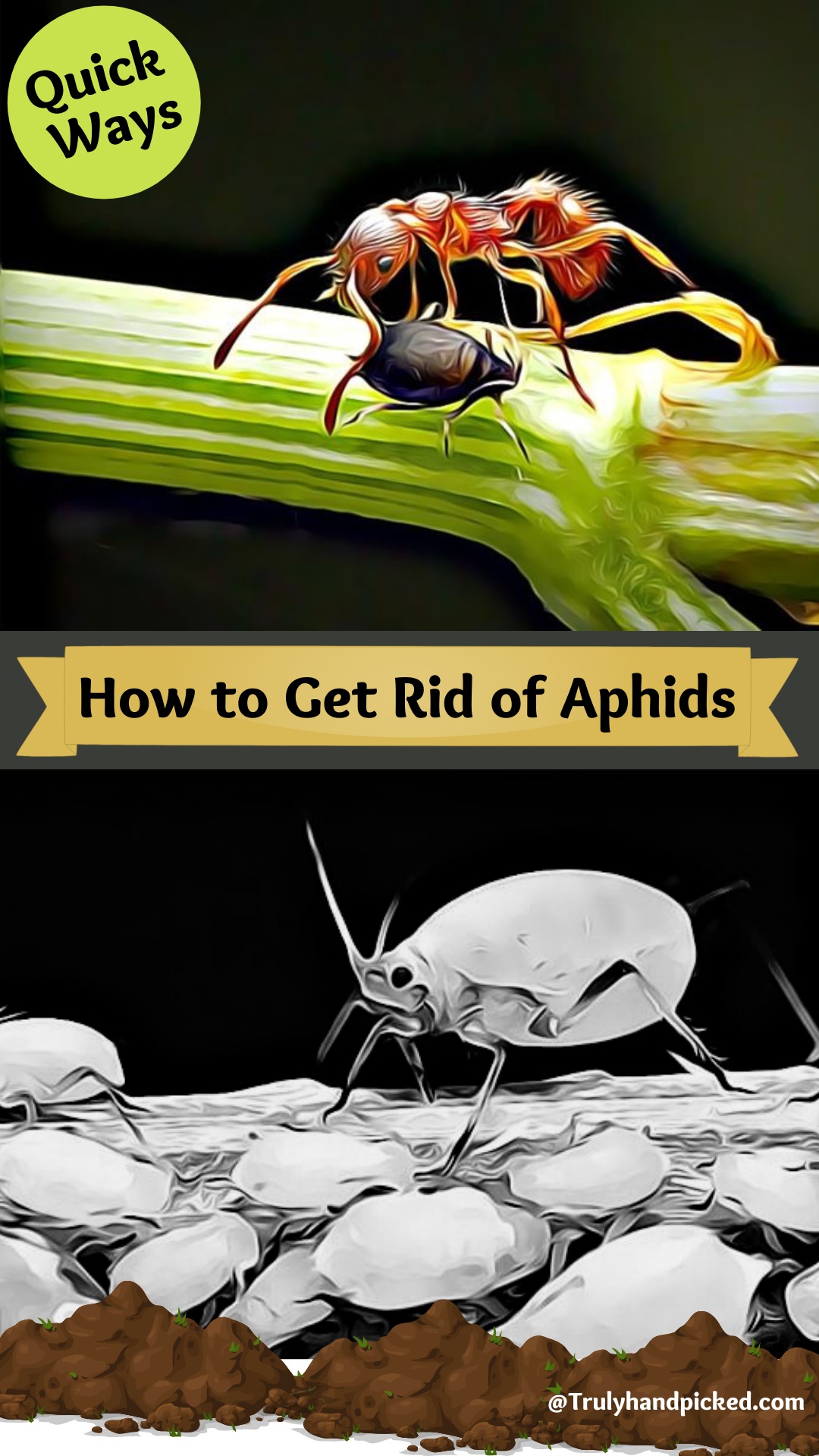Aphids or tree lice are one type of the most destructive and disgusting plant insect that can damage the overall health of your plants severely. If you don’t treat aphids at the primary stage, they can even destroy the entire garden solitarily. Besides, aphids are harmful to our natural surroundings or our environments as well.
Providentially, some smart moves can save us from this crisis, if we apply them appropriately in time. Let’s see what these tree lice actually are and how to get rid of them easily from your favorite garden plants-
What do Aphids Look Like & How to Identify Them?
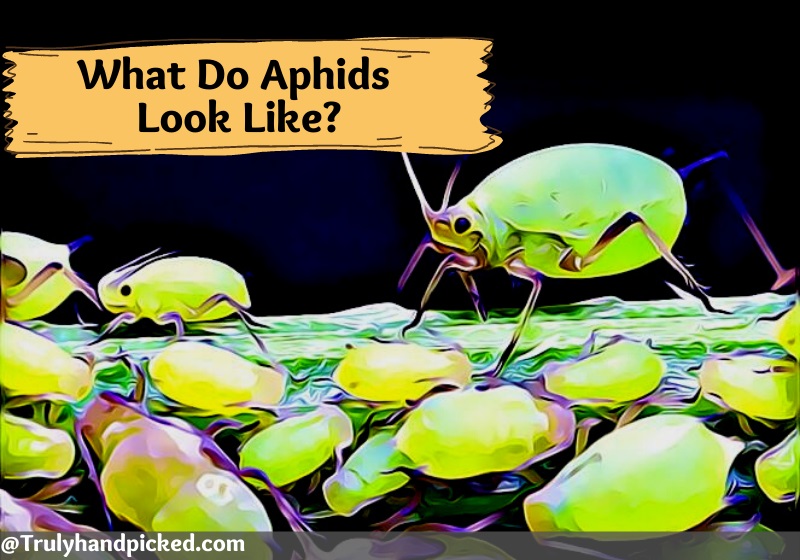
What are aphids?
Aphids are tiny creatures that can merely reach the length of 4-6mm at their peak age. The young aphids and nymphs are quite invisible to bare eyes sometimes.
- Aphids are mostly pear-shaped and come in different shades like brown, grey, red, green, black, yellow, orange, and pink too.
- These pests have long antennae and are mostly surrounded by smaller clones of themself. Mother aphid surrounded by daughter clones.
A few species have a waxy coating around their body. The tiny torso of the aphid shape is like a pear. They have long antennae and they carry the same look from their very beginning stage to adulthood.
Just like mealybugs these soft-bodied bugs suck sap from the plants and produce honeydew. Honeydew is a sticky sugary substance that attracts ants and also it turns black because of sooty mold.
Aphids infestation on plants
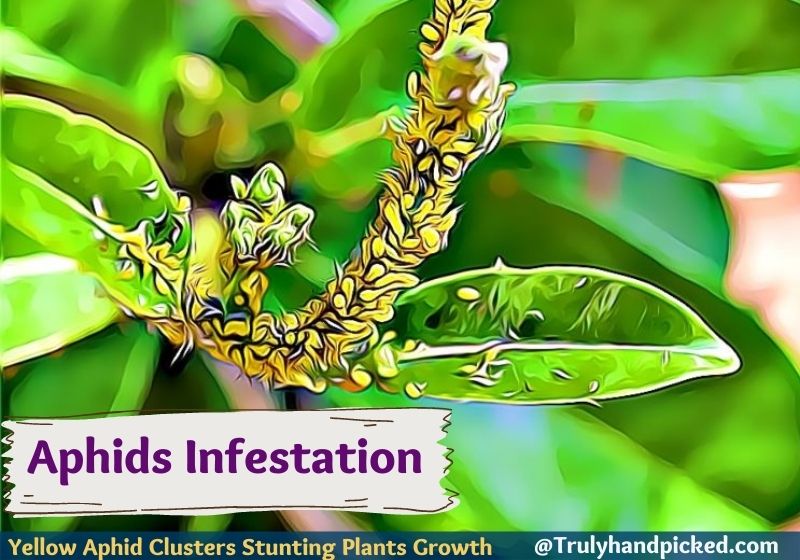
- Once aphids appear in your plants, leaves, and stem growth will be stunted
- Curling of leaves
- Leaves of your infected plant turn yellowish
- Deformed shape of your plant leaves and stem as well
- Honeydew, ants, and black sooty mold on your plant leaves
- Clusters of tiny greenish insects (brown, grayish) on stem tips, buds, and young leaves.
If you find that the stem or any underside area of a leaf seems covered with a gluey substance(sugary honeydew), be sure that your plant is infested with the attack of aphids.
Where do Aphids Come From and Reasons for Infestation?
This unfriendly insect usually comes from North America and gradually spreads over the world. They are addicted to the juicy succulent plants and feed on their sap. Aphids seem more active during the Spring season and can spread their infestation more in this period.
If you wonder where do they come from to your garden, then you must scrutinize your actions that instigate the spread of aphids in your yard. Some actions that invite aphids to your garden are-
- Aphids are brought to your house through an infested plant or wind or even by clinging to your clothing. That’s enough to start a new colony and infest your houseplants
- A neglected garden plant in your premises or in the neighborhood is vulnerable and prone to attack.
- Poor soil, drainage, and overly crowded plants per square space.
- Using nitrogen-rich fertilizer more often
- Your garden plants are exceptionally rich in fluids and thriving
- If you don’t prune or clean your plants on a schedule
- And if you never apply any spray be it natural or readymade insecticide on your plants
What do Aphids Eat?
Being herbivores aphids only take their essential nutrients from plants. They pierce the plant with sharp mouthparts and suck the fluids from plants’ stems, leaves, or roots. Aphids can’t bite or chew leaves or stems, they only suck the sap from your plants. They are fond of sugary plant juice more as sweet juice provides them with more protein content.
Later aphids excrete sticky sugar from their body, as they consume much more sugary juice from the plants than they actually require. And this sticky sugar is called honeydew and it is mostly excreted by similar injects which feed on plant fluids. As they suck the sap from the leaves and stem, your plant leaves will wilt, turn yellow, or curl and heavily infested plant may even die. So, if you have such plants in your garden, be sure that aphids can invade your garden plants.
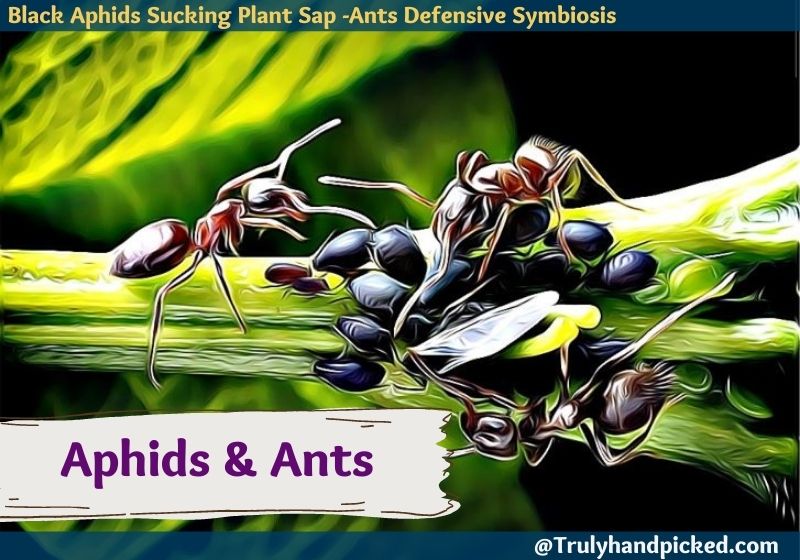
Ants and Aphids Relationship:
As we all know ant species are smart and one of the oldest farmers on earth, trade protection, and get food from aphids. It’s beneficial for both and it is termed as defensive symbiosis, where the ant colony consumes the sugary honeydew from aphids and gives protection. Beyond protection from enemies, they also take the aphids to their nest and bring them back to the spot. Also when the ant colony shifts to a new place they take few eggs of aphids to herd them in the new place to provide food.
What do aphids do and how it is harmful to your plants?
- They directly attack the plant by anchoring their sharp mouth on your plants and suck the sap. Distorting the plant to curl, loose leaves, and by injecting toxins altering its system, and eventually die at last.
- Secondly, it interrupts the plant’s photosynthesis process indirectly by secreting honeydew. The fungus uses it as a medium and later covers the whole leaf and blocks sunlight.
- Beyond all aphids (winged species) can carry and transmit viruses into a healthy plant making it weak and die or become a host.

How to Get Rid of Aphids On Plants:
1. Vegetable Oil on Aphids:
How: Insects don’t breathe through their mouth or nose, instead they use their spiracles on their body to respire. So using oil spray with block the pores and make them suffocate and die (asphyxiation).
Method: Take 1 Tbsp of vegetable oil with 1 cup of water and 1 teaspoon of soap in a spray bottle. Shake the bottle to mix them up thoroughly and spray this mixture on the aphids-infected area often until they are gone forever.
2. Homemade Neem Oil Spray for Aphids
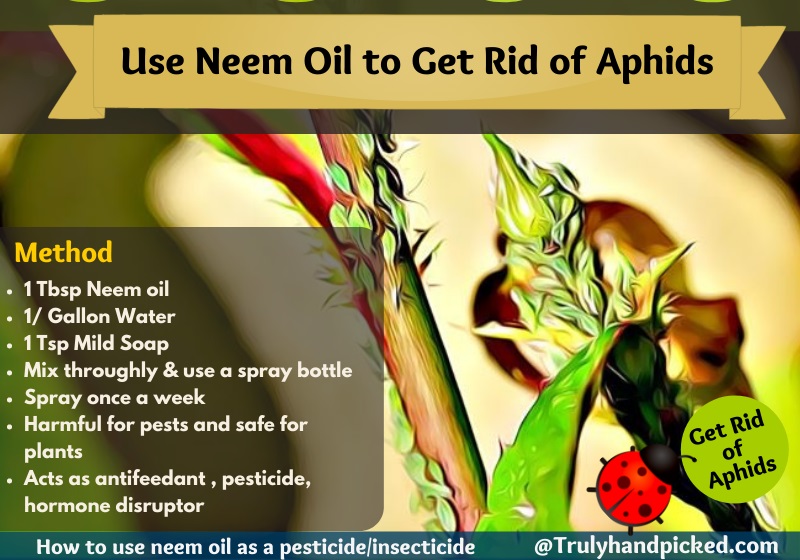
Neem oil is not harmful to your plants and garden-friendly bugs and beetles while it slowly kills insects like aphids and similar harmful plant pests. Neem oil is an insecticide to kill soft-bodied insects like aphids, mealybugs, whiteflies, and mites. Also, it is a fungicide to prevent fungal infections.
Neem oil acts as an antifeedant surprising the aphids’ feeding. Also, it is a hormone disruptor that interrupts the insect’s growth and life cycle and also.
How to:
- Take 1 tsp of mild dish soap with 1/2 gallon water in an empty spray bottle, later pour 1tbsp of the neem oil.
- Shake well and spray the mixture on infested plant’s leaves, stem tips, and under the leaves.
- Repeat it once a week to get the best outcome of this remedy.
- Always mix neem oil spray in small batches.
- Also, avoid using neem oil in midday and on seedlings as it could burn the leaves.
3. Introduce Predators
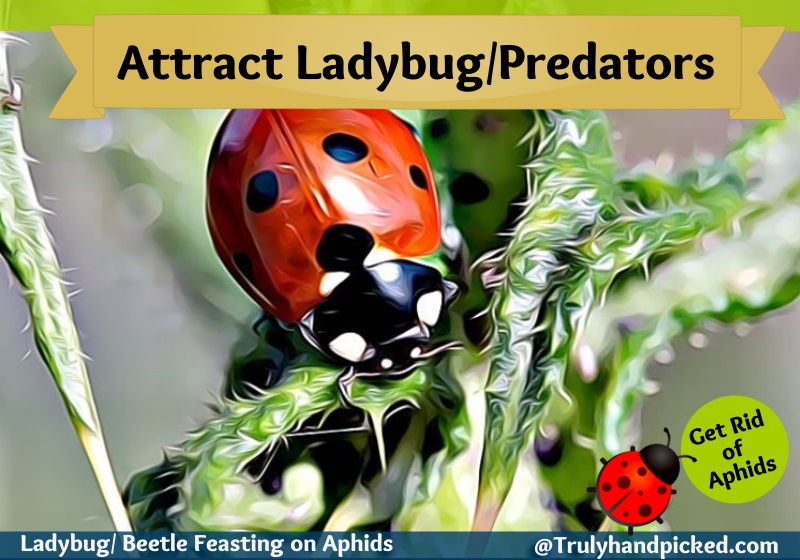
Plant some garden plants in your garden that attract aphid predators like ladybugs, ground beetles, green lacewings, lacewings, etc. These predators are gardenly friendly bugs that help in pollination and play a great role to get rid of mealybugs and aphids.
Plants that attract ladybugs to kill aphids:
- Cosmos
- Angelica
- Cilantro
- Geranium
- Fennel
- Parsley
- Butterfly Weed
- Calendula
- Yarrow
- Tansy
- Dill
- Caraway
- Chives
- Coreopsis
4. Essential Oil
The Aroma richness of essential oils helps to repel harmful pests and thus works efficiently as a home remedy for such pests. Rosemary, peppermint, thyme, etc. essential oils are efficient in this attempt. Take 1 teaspoon of any essential with a quart of water into a spray bottle and sprinkle over the aphid-infected area of your plant repeatedly until they are cleaned completely.
5. Soapy Water
Insecticidal soap or homemade in mild washing liquid soap water is also good enough to kill aphids. This homemade soap spray is just like a mineral oil spray, yes it smothers the pests.
- Mix 2 tsp of liquid dish soap in 2 cups of water in a spray bottle and mix thoroughly.
- Spray this mixture regularly on the infected area or wipe it on leaves for small plants for a couple of days until the aphids are gone.
- Twice a week is recommended to prevent over-usage also test it on parts of your plant before going for a full spray.
Few More Natural Ways to Remove Aphids to Get Rid Aphids Permanently:
Some other natural ways of removing aphids from your garden plants are like-
- Blast the bugs with a steady stream of water over the aphid clusters (in the case your plant is not sensitive to water blast).
- Clear any ant-gathering around your plants as they protect and encourage aphids to extend
- Sprinkle deadly diatomaceous earth powder on the infected area of your plants.
- Plant banker plants that supply a steady source of food for predators.
- Remove weeds that act as a reservoir for aphids, which is more or less like a backup for aphid eggs.
- Dust the stem and leaves of your infected plants with all-purpose flour.
- Build a birdhouse or bird feeder in your garden to attract birds or bug-eating birds. Chickadees, house sparrows, titmice, bluebirds, wrens, etc. are some helpful birds in this regard
- Manually remove the bugs or brush them off to decrease the intensity and spread.
- And stay updated by checking your garden plants consistently for any sign of aphids, so, then, you can control and repel them at the primary stage quickly.
Baking Soda & Epsom Salt
Baking soda is yet another best homemade remedy for aphids. Moreover, this doesn’t hamper the health of your plants, unlike normal pesticide sprays yet clear the grasp of aphids expertly. Also, baking soda spray keeps the whiteflies, mites, and foliar diseases under check and prevents powdery mildew and fungal spores.
- Mix 1 tbsp of bicarb soda, ½ tbsp of oil, and 1tsp of Epsom salt in 1/2 gallon water.
- Apply it like other typical pest-repellent sprays at intervals.
Types of Aphids
The most common type of aphids is green peach and melon aphids which can cling and colonize on a large number of plants. list of few mentionable types of aphids
- Bean Aphid
- Cabbage Aphid
- Green Peach Aphid
- Melon Aphid
- Green Apple Aphid
- Leaf curl plum Aphid
- Mealy plum Aphid
- Rosy Apple Aphid
- Hackberry woolly Aphid
- Oleander Aphid
- Rose Aphid
- Potato Aphid
- Woolly Apple Aphid
- Ash leaf curl Aphid
- Crapemyrtle Aphid
- Giant conifer Aphid
- Tuliptree Aphid
Root Aphids:
The roots of some plants also get infested by Aphids like stems and leaves. Plants with sugary roots mostly have such problems. When Aphids suck all the juicy texture from the stem above the root line and found another source below, they attack the root instantly.
After a certain period, they bore into the root and start creating scars on that surface. This action often makes the plant vulnerable to mildew and some undetectable diseases.
FAQ: Aphids on Your Plants
Are Aphids Harmful to Humans?
Aphids can’t bite or provide any type of harm to humans. They are just utter nuisance and provide bad influence to our environments, especially for their woolly substance.
Do Aphids Fly – Winged Aphids
No not all generations of aphids can fly. Mostly aphids can’t fly, only crawl, and go plant to plant with the help of ants. They even sometimes drop off to the ground from stem or leaf to get out of the grasp of their predators.
But, when there is not enough room for all, a new generation with wings is born which migrate and start the cycle.
Lifecycle of Aphids & Aphid Eggs:
- First-generation of aphids on a plant starts in the spring after the eggs survive the extreme winter (overwinter).
- Always the first generation from these eggs is females.
- Each aphid can produce 70+ aphids in her 4 weeks lifespan.
- During the spring and summertime, only exact clones (daughters) of mother aphids are born alive from adult aphids rather than hatching from eggs.
- When the fall is around the corner generation of males and females are born to mate and lay eggs before winter and this completes their life-cycle.
- In the meantime, the growth is exponential because of cloning, and numerous generations within a year, and this results in increased aphid clusters. If enough measures are applied you can interrupt the cycle to save your plants and trees.
Can I use aphid-infested soil for repotting?
No, you can’t! As aphid-infested soil contains eggs that are microscopic and can’t be seen with bare eyes. Also, infected soil can bring back the aphids colony in no time even before you could notice it. So, for repotting use sterile soil/potting mix and clean washed pot and saucers for your house plants.
